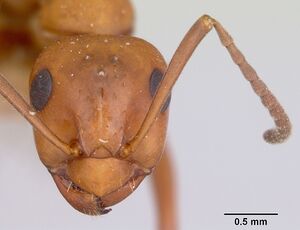Formica nepticula
| Formica nepticula | |
|---|---|

| |
| Scientific classification | |
| Kingdom: | Animalia |
| Phylum: | Arthropoda |
| Class: | Insecta |
| Order: | Hymenoptera |
| Family: | Formicidae |
| Subfamily: | Formicinae |
| Tribe: | Formicini |
| Genus: | Formica |
| Species group: | microgyna |
| Species: | F. nepticula |
| Binomial name | |
| Formica nepticula Wheeler, W.M., 1905 | |
| At a Glance | • Temporary parasite |
Identification
The workers of this species are bicolored, with the head, mesosoma, petiole, and appendages yellowish red, with the gaster medium brown. Erect hairs are abundant on most surfaces, including the dorsum of the head, ventral surface of the head, the scape often has a few scattered, erect hairs, hairs are present on the dorsum of the mesosoma, dorsum of the petiole, and the gaster, hairs the tibiae are suberect. Many of the hairs, especially those on the mesosoma, are blunt-tipped.
The queen is a tiny specimen, much smaller than the largest worker, mostly pale yellowish brown, with numerous hairs on the same surfaces as the workers, the hairs are longer, and not noticeably blunt-tipped. The scape has a few, scattered, erect hairs.
This species could be confused with Formica knighti. To it differs in that the dorsum of the gaster is punctate, but is weakly to moderately shining, not dull as in F. knighti. It does not have the abundant erect an suberect hairs on the scapes and tibiae that are found in Formica impexa and Formica microgyna.
Keys including this Species
Distribution
Latitudinal Distribution Pattern
Latitudinal Range: 44.917° to 41.237667°.
| North Temperate |
North Subtropical |
Tropical | South Subtropical |
South Temperate |
- Source: AntMaps
Distribution based on Regional Taxon Lists
Nearctic Region: United States (type locality).
Distribution based on AntMaps
Distribution based on AntWeb specimens
Check data from AntWeb
Countries Occupied
| Number of countries occupied by this species based on AntWiki Regional Taxon Lists. In general, fewer countries occupied indicates a narrower range, while more countries indicates a more widespread species. |

|
Estimated Abundance
| Relative abundance based on number of AntMaps records per species (this species within the purple bar). Fewer records (to the left) indicates a less abundant/encountered species while more records (to the right) indicates more abundant/encountered species. |

|
Biology
This species is likely to be a temporary parasite of another species of Formica, but its host is unknown.
Castes
Worker
Images from AntWeb
   
| |
| Cotype of Formica nepticula. Worker. Specimen code casent0105608. Photographer April Nobile, uploaded by California Academy of Sciences. | Owned by USNM, Washington, DC, USA. |
   
| |
| Worker. Specimen code casent0103384. Photographer April Nobile, uploaded by California Academy of Sciences. | Owned by USNM, Washington, DC, USA. |
Queen
Images from AntWeb
    
| |
| Queen (alate/dealate). Specimen code casent0103383. Photographer April Nobile, uploaded by California Academy of Sciences. | Owned by USNM, Washington, DC, USA. |
Nomenclature
The following information is derived from Barry Bolton's Online Catalogue of the Ants of the World.
- nepticula. Formica nepticula Wheeler, W.M. 1905c: 270 (w.q.m.) U.S.A. See also: Wheeler, W.M. 1913f: 475.
Type Material
- Syntype, workers, queens, 2 males, summit of Mt. Pisgah, Colebrook, Litchfield County, Connecticut, 1400ft., United States, 42°00′0″N 73°6′0″W / 42°N 73.1°W, W.M. Wheeler, Museum of Comparative Zoology.
- Syntype, workers, Blackhawk Springs (as Black Hawk Spring), near Rockford, Illinois, United States, 42°12′0″N 88°59′0″W / 42.2°N 88.983333°W, W.M. Wheeler, Museum of Comparative Zoology.
Description
References
- Borowiec, M.L., Cover, S.P., Rabeling, C. 2021. The evolution of social parasitism in Formica ants revealed by a global phylogeny. Proceedings of the National Academy of Sciences 118, e2026029118 (doi:10.1073/pnas.2026029118).
- Wheeler, W. M. 1905. New species of Formica. Bull. Am. Mus. Nat. Hist. 21: 267-274 (page 270, worker, queen, male described)
- Wheeler, W. M. 1913. A revision of the ants of the genus Formica (Linné) Mayr. Bulletin of the Museum of Comparative Zoology 53: 379-565 (page 475, see also)
References based on Global Ant Biodiversity Informatics
- Coovert, G.A. 2005. The Ants of Ohio (Hymenoptera: Formicidae) Ohio Biological Survey Bulletin New Series Volume 15(2):1-196
- Del Toro, I. 2010. PERSONAL COMMUNICATION. MUSEUM RECORDS COLLATED BY ISRAEL DEL TORO
- Shik, J., A. Francoeur and C. Buddle. 2005. The effect of human activity on ant species (Hymenoptera: Formicidae) richness at the Mont St. Hilaire Biosphere Reserve, Quebec. Canadian Field-Naturalist 119(1): 38-42.
- Talbot M. 1976. A list of the ants (Hymenoptera: Formicidae) of the Edwin S. George Reserve, Livingston County, Michigan. Great Lakes Entomologist 8: 245-246.
- Wheeler G. C., J. N. Wheeler, and P. B. Kannowski. 1994. Checklist of the ants of Michigan (Hymenoptera: Formicidae). The Great Lakes Entomologist 26(4): 297-310
- Wheeler W. M. 1905. New species of Formica. Bulletin of the American Museum of Natural History 21: 267-274.
- Wheeler, G.C., J. Wheeler and P.B. Kannowski. 1994. CHECKLIST OF THE ANTS OF MICHIGAN (HYMENOPTERA: FORMICIDAE). Great Lakes Entomologist 26:1:297-310

